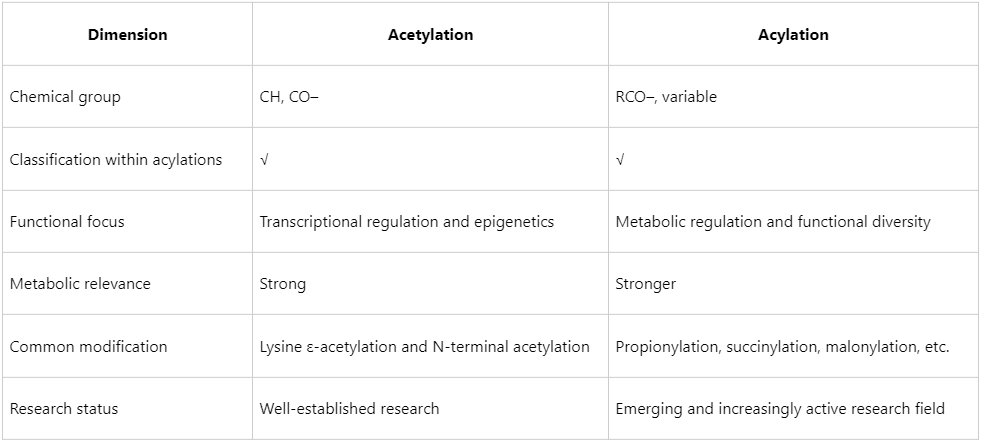What Is the Differences Between Protein Acetylation and Acylation?
- Epigenetic regulation: histone acetylation alters chromatin structure and modulates gene expression
- Regulation of signal transduction pathways
- Control of enzymatic activity
- Modulation of protein–protein interactions
- More directly reflects the intracellular metabolic state
- Specific acylations are associated with energy metabolism (e.g., the TCA cycle and fatty acid oxidation)
- May alter the net charge and conformational dynamics of proteins
- Acetylation is primarily regulated by intracellular acetyl-CoA concentrations
- Other acylations depend on various metabolic intermediates
- Highly efficient immuno-enrichment strategies (anti-acetyl-Lys antibodies)
- High-resolution mass spectrometry (e.g., Orbitrap Eclipse)
- Parallel enrichment of multiple acyl modifications
- Optimized database search algorithms supporting PTM analysis
In cellular processes, protein post-translational modifications (PTMs) represent essential mechanisms for regulating protein function, stability, localization, and molecular interactions. Among them, protein acetylation and acylation are two major types of covalent modifications that attach specific chemical groups to defined amino acid residues, most commonly targeting the ε-amino group of lysine (Lys).
Basic Definition: Acetylation as a Subclass of Acylation
1. Protein Acetylation
Protein acetylation refers to the covalent attachment of an acetyl group (CH₃CO−) to a protein, typically occurring at lysine residues or the N-terminus. Depending on the modification type, acetylation can be categorized as:
(1) N-terminal acetylation
(2) Lysine ε-acetylation
2. Protein Acylation
Protein acylation is a broader term describing the covalent modification of proteins with various acyl groups (RCO−) derived from fatty acid metabolites. These include, but are not limited to:
(1) Acetylation (C₂)
(2) Propionylation (C₃)
(3) Butyrylation (C₄)
(4) Valerylation (C₅)
(5) Succinylation
(6) Malonylation, among others
Therefore, acetylation is a specific subset of acylation: while every acetylation event is an acylation, not every acylation represents acetylation.
Differences Between Protein Acetylation and Acylation
1. Substrate and Site Specificity
(1) Common features:
Most acyl modifications occur on lysine residues (ε-NH₂) and exhibit high reversibility, participating in the fine-tuned regulation of transcription and metabolism.
(2) Distinct features:

2. Functional Divergence: Acetylation in Transcriptional Regulation vs. Acylation in Metabolic Coupling
(1) Functions of protein acetylation:
(2) Functions of protein acylation (broadly defined):
3. Enzymatic Mechanisms

4. Bridge Between Metabolism and Epigenetics: Acylation as a More Sensitive Indicator
Both acetylation and acylation serve as molecular sensors of cellular metabolic status:
Consequently, comprehensive acylation profiling serves as a precise indicator of metabolic states, marking a critical intersection between metabolomics and proteomics.
Summary: Core Distinctions Between Acetylation and Acylation

MtoZ Biolabs Solutions
The MtoZ Biolabs platform integrates:
Together, these technologies enable high-sensitivity, high-coverage, and reproducible acylation proteomics analyses, facilitating the elucidation of key metabolic regulatory mechanisms. Researchers interested in profiling protein acetylation and acylation patterns in specific cell lines or biological samples are encouraged to contact MtoZ Biolabs for comprehensive, customized workflows, from sample preparation to data interpretation, designed to advance scientific discovery.
MtoZ Biolabs, an integrated chromatography and mass spectrometry (MS) services provider.
Related Services
How to order?







